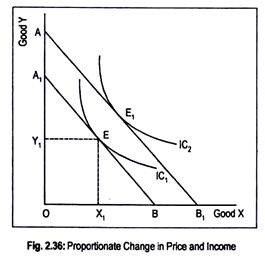Let us learn about proportionate change in price and income.
The optimum position is reached when the budget line becomes tangential to the indifference curve. Now this optimum or equilibrium position will change if there is either a change in money income or prices of one of the two goods.
Now the question is:
How will the equilibrium of the consumer be affected if money income and price of both the goods change in the same proportion and in the same direction? Suppose money income is doubled and if prices of two goods are also doubled then equilibrium position of the consumer will remain unchanged. This is shown in Fig. 2.36.
AB is the initial budget line and the consumptive optimum—or equilibrium of the consumer—is at point E where he consumes OX1 of X and OY1 of Y. If now money income rises, budget line should shift to A1B1 and equilibrium point should occur at point E1.
This suggests that our consumer should purchase more of both X and Y. Now, if prices of X and Y also increase by the same amount as income rose, real income would decline. This amounts to saying that now the budget line would shift back to the original position. In other words, A1B1 line would shift back to AB and equilibrium position would remain unchanged.
There is no reason why the consumer would buy more of the two goods. Thus, the demand for X and Y would remain invariant when there is a proportionate change in money income and prices of two goods. Mathematically, such a demand function is said to be homogenous of degree zero in all prices and money income.
